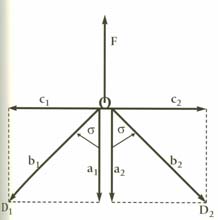Appendix B
If O is a point is space representing the sphincter, a force F,
representing the tension applied to it by LM contraction, will be opposed in
the plane by the phrenoesophageal ligaments represented by the two vectors b1
and b2 . The projections of b1
and b2 on the vertical are a1
and a2. The vertical components are both in the
opposite direction to F and counteract its tendency to elevate
point O. In the same way, c1 and c2
are the projections of b1 and b2
in the horizontal direction.
From the geometry we can write:
a1 = b1 cos sigma
a2 = b2 cos sigma
c1 = b1 sin sigma
c2
= b2 sin sigma
a1 = a2
c1 = -c2
The sum of the a1 and a2
vectors will prevent upward translation of point O. The effect of the c1
and c2 vectors, which are of opposite
sign, will be to pull point O in opposite directions.
If O, instead of being a point, is a minute annulus representing the inner
surface of a closed sphincter, the effect of the c vectors
will be to separate the opposite walls. If the whole diagram is rotated about
the vertical axis distributing these vectors in 3 dimensions, all of the periphery
of the closed sphincter will be spread open without any lateral translation
of the sphincter itself.
The detailed distribution is extremely difficult to model mathematically because
the diaphragm, the esophagus and the PEL are all elastic, not rigid structures.
Because of this, point O is elevated as the PEL stretches and the angle changes.
Nevertheless, it is clear that the pull of the contraction LM will have two
effects: 1.) It will open the sphincter and 2.) It will stretch the PEL producing
a "sliding hiatus hernia."
If equivalent force is applied at the endpoints of the PEL, D1 and D2 by the diaphragmatic contraction of a hiccup, the resulting distribution of forces will be identical. Thus a hiccup is the mechanical equivalent of a contraction of the LM and has the same effect in releasing the sphincter.The PEL is essential to this force resolution. When it ruptures, reflux is alleviated.
Last Updated July 31 2007 by David PJ Stiennon
